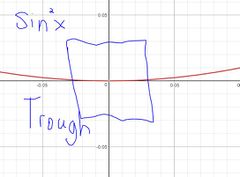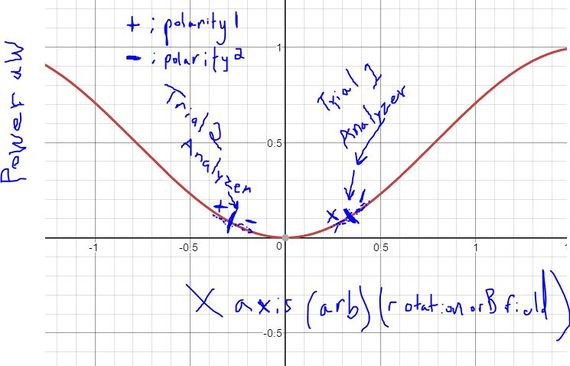Difference between revisions of "Kerr - June 28, 2016"
(Created page with "June 27th and 28th, I worked on reaching the absolute minimum power with the cross polarizers {an exact 90 degree angle}. I was able to reach .0020 uW which is .0100 uW better...") |
|||
| (9 intermediate revisions by the same user not shown) | |||
| Line 1: | Line 1: | ||
| − | June 27th and 28th, I worked on reaching the absolute minimum power with the cross polarizers {an exact 90 degree angle}. I was able to reach .0020 uW which is .0100 uW better than before. It seems at this close to the minimum there is no change in the light coming through when the foil is magnetized. When I took the magnets in my hand and brought them closer to the foil there was no change in power, the power meter read .0020 uW consistently. I tried this several times and still saw no change. | + | June 27th and 28th, I worked on reaching the absolute minimum power with the cross polarizers {an exact 90 degree angle}.[[file:sintrough.jpeg|thumb|upright=.8|Here is a sin^2 trough up close. Our values are so small it may be close to impossible to read a change with the slope being practically zero.]] I was able to reach .0020 uW which is .0100 uW better than before. It seems at this close to the minimum there is no change in the light coming through when the foil is magnetized. When I took the magnets in my hand and brought them closer to the foil there was no change in power, the power meter read .0020 uW consistently. I tried this several times and still saw no change. This may be because we are dealing with a sin^2 shape. Near the minimum the slope is downright close to 0. [[file:sin2x.jpeg|thumb|upright=1.9|sin^2 graph showing the experiment in order to show the shape of the curve]] |
| − | I then thought of an experiment to see the shape around the minimum when it comes to power vs. a relative rotation. Around the minimum there should be something like a bowl shape. In our example it would be the trough of a sin^2 wave. If I were to approach the minimum from different sides and take readings, I should see opposite slopes for the same polarities. To be more clear, as I approach the minimum from say the | + | I then thought of an experiment to see the shape around the minimum when it comes to power vs. a relative rotation. Around the minimum there should be something like a bowl shape. In our example it would be the trough of a sin^2 wave. If I were to approach the minimum from different sides and take readings, I should see opposite slopes for the same polarities. To be more clear, as I approach the minimum from say the left, lets say polarity 1 will increase the power as it rotates the light away from 90 degree interception. Polarity 2 in this case should decrease the power as it rotates the light towards a 90 deg interception. Now coming in from the right side towards the minimum, polarity 1 will decrease the power as it rotates the light towards the 90 deg interception and polarity 2 will increase the power as it rotates the light away from the perfect interception. See 2nd Diagram--> |
Now that I think about it, since we are dealing with a sin^2 graph, I think it is possible when we are so near the minimum since the graph is very rounded that it is impossible to see a .0015 uW change. It makes sense we would see this change on the slope side of the graph since it happens a bit more drastically. | Now that I think about it, since we are dealing with a sin^2 graph, I think it is possible when we are so near the minimum since the graph is very rounded that it is impossible to see a .0015 uW change. It makes sense we would see this change on the slope side of the graph since it happens a bit more drastically. | ||
| + | |||
| + | |||
| + | |||
| + | |||
| + | To see this experiment accomplished successfully --> [[Kerr - June 29, 2016]] <---------------------------------------> | ||
Latest revision as of 16:25, 29 June 2016
June 27th and 28th, I worked on reaching the absolute minimum power with the cross polarizers {an exact 90 degree angle}.
I was able to reach .0020 uW which is .0100 uW better than before. It seems at this close to the minimum there is no change in the light coming through when the foil is magnetized. When I took the magnets in my hand and brought them closer to the foil there was no change in power, the power meter read .0020 uW consistently. I tried this several times and still saw no change. This may be because we are dealing with a sin^2 shape. Near the minimum the slope is downright close to 0.
I then thought of an experiment to see the shape around the minimum when it comes to power vs. a relative rotation. Around the minimum there should be something like a bowl shape. In our example it would be the trough of a sin^2 wave. If I were to approach the minimum from different sides and take readings, I should see opposite slopes for the same polarities. To be more clear, as I approach the minimum from say the left, lets say polarity 1 will increase the power as it rotates the light away from 90 degree interception. Polarity 2 in this case should decrease the power as it rotates the light towards a 90 deg interception. Now coming in from the right side towards the minimum, polarity 1 will decrease the power as it rotates the light towards the 90 deg interception and polarity 2 will increase the power as it rotates the light away from the perfect interception. See 2nd Diagram-->
Now that I think about it, since we are dealing with a sin^2 graph, I think it is possible when we are so near the minimum since the graph is very rounded that it is impossible to see a .0015 uW change. It makes sense we would see this change on the slope side of the graph since it happens a bit more drastically.
To see this experiment accomplished successfully --> Kerr - June 29, 2016 <--------------------------------------->

